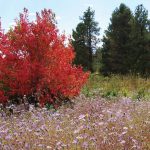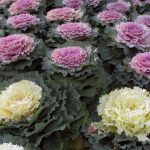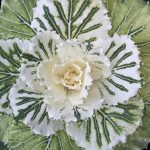by Ken Lain, the mountain gardener
Sumacs and flame maples have drawn our attention to those first hints of autumn.  Chrysanthemums are in their full glory, and everywhere we turn we find pumpkins are in coffees, teas, beers, and even ice creams! Fall has arrived. Most autumn flowers are an amazing group of plants that will bloom all the way through next spring.
Chrysanthemums are in their full glory, and everywhere we turn we find pumpkins are in coffees, teas, beers, and even ice creams! Fall has arrived. Most autumn flowers are an amazing group of plants that will bloom all the way through next spring.
Ornamental cabbage and kale are in the same species as edible cabbages and kale. They are the result of hybridizing and, although they are edible, they aren’t as tasty and  tender as their “veggie” cousins. Although sometimes referred to as flowering cabbages, the leaves, not blossoms, give the plants their color and interest as ornamentals.
tender as their “veggie” cousins. Although sometimes referred to as flowering cabbages, the leaves, not blossoms, give the plants their color and interest as ornamentals.
Flowering cabbage and kale look like edibles, but they have rosy and/or white ornamental foliage. Plants with smooth leaf margins are considered flowering cabbage.  Plants with serrated or fringed leaf margins are considered ornamental kales, which are divided into the “fringed leaf cultivars” and the “feather leaved cultivars”. I wouldn’t make too fine a point about the labeled differences.
Plants with serrated or fringed leaf margins are considered ornamental kales, which are divided into the “fringed leaf cultivars” and the “feather leaved cultivars”. I wouldn’t make too fine a point about the labeled differences.
No one variety is better than another. Certain colors and leaf shapes will call to you, and those are the ones to put in your garden. More than 10 different plant varieties are offered here at Watters Garden Center. Our seed packets are labeled simply “Ornamental Cabbage”. When starting these beauties from seed it’s best to just choose a color combination that you like and thin the seedlings that are least appealing to you.
Ornamental cabbages and kales look especially good in a large planting, where their color really stands out. Since they are low growers, you’ll often see them as edging plants, where their purplish hues blend in well with other fall colors.
If you only want one or two plants, they look less out of place in containers, than they do scattered throughout a garden. In fact, they make nice autumn replacements for spent summer containers.
Growing Tips – Ornamental cabbages and kales prefer to be grown in cool weather, making now through November their best time for planting. When buying plants, opt for larger plants, even though you’ll pay a little more. Once cabbages get root bound, the top portions become stunted and struggle to fill out the way they’re expected to do. Look for plants with short stems and relatively uniform length leaves, no insect holes and at least a hint of color.
Both cabbages and kales prefer a slightly acidic pH of about 5.8 – 6.5. They like to dry out slightly between watering, but stress if left dry for prolonged periods.
Growing Ornamental Cabbage from Seed: Sow seeds 3-4 months before you need full sized plants and at least 6-10 weeks before a frost is expected. If you start seeds in cell packs or flats, be sure to transplant to larger pots as soon as the first true leaves appear. You don’t want to risk them getting pot bound so young.
Since the weather will be warm, you could simply direct seed your cabbages in the garden. Cover lightly with soil and keep the soil moist until germination. Seeds should sprout within 1-2 weeks. Thin to about 18-24″ apart, when seedlings are 3-4 inches tall.
Maintenance: Ornamental cabbages and kales can last throughout the winter, but their appearance depends a lot on the weather. Too hot and they will bolt, too wet and harsh and they’ll look tattered. Since most insects are scarce in the cooler months, there are few problems from the usual plant pests. Aphids seem to be the most persistent pests, although cabbage looper, and leaf roller are still active in some areas, and powdery mildew can become a problem if autumn is damp. Watch out for javalinas, as they find these ornamentals as tempting as edible cabbages.
~ * ~
Garden Critical – The first days of October are when gardeners must implement the most important garden treatment of the year. By the end of the month everything in our gardens should be fed with ‘All Purpose Plant Food’ 7-4-4. This includes native pines and junipers. Fertilize with confidence with this all natural food, as it is safe for people and pets in your yard. You’ll tire of my harping, but this is important . . . ‘Feed everything in the garden by the end of the month’.
Ken Lain can be found throughout the week at Watters Garden Center, 1815 W. Iron Springs Rd in Prescott, or contacted through his web site at WattersGardenCenter.com or FB.com/WattersGardenCenter .

